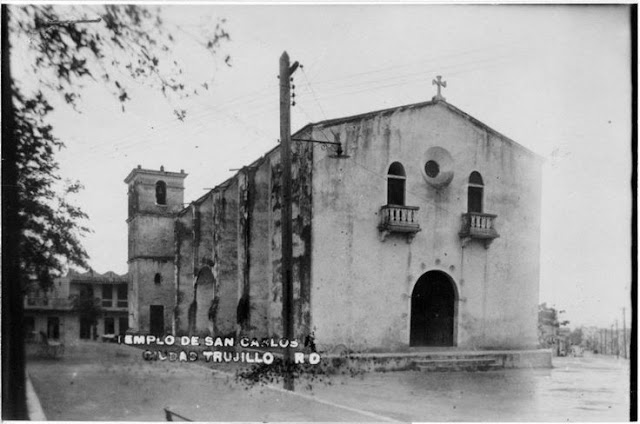 |
| Iglesia de San Carlos Borromeo, San Carlos de Tenerife, in the 1930's |
San Carlos de Tenerife, today in the centre of the city of Santo Domingo, Dominican Republic, was the only independent jurisdiction on the outskirts of the capital and an example of the struggle and tenacity of the Canarians for having their own town and parish despite the interest of the capital's oligarchy.
A tenacity that explains their resistance to being assimilated by the city and to maintain their own town hall until 1911; an identity that, although today transformed by the destruction of part of the neighbourhood and the cultural uprooting characteristic of its absorption by a large city, has made a pride and awareness of belonging to a singular group in a city with a mulatto majority.
The history of San Carlos de Tenerife
The history of San Carlos begins in 1684 with the arrival of 97 families, a total of 543 people, from the Canary Islands, taken on ships belonging to the Sevillian, Ignacio Pérez Caro, in exchange for mercantile privileges and the position of Captain General of the Island. The lack of sanitation greatly affected the newcomers. In the first moments there was an intention to distribute them throughout the territory, but later it was decided to concentrate them in a single point, El Higuerito or El Higuero, six leagues from the capital, which would become the first site of the town of San Carlos de Tenerife.
At first it was considered suitable and they had even been assigned land and had been provided with money, corn, axes and tools and its town hall had been erected. But, shortly after, a serious epidemic broke out, and if they didn't leave that place as soon as possible, they would all perish. It was smallpox, which claimed 126 victims and left the rest in poor condition. The survivors wandered around the capital sustaining themselves by carrying firewood from the mountains and eating wild fruits. The Crown urged the governor to find another location.
Finally, they themselves chose the place that they considered most suitable, a promontory near Santo Domingo, against the opinion of the capital city council, which wanted their distribution between the neighbourhoods of San Antón, San Michael and Saint Lazarus. Despite this covert objective of the capital's elite to control the new population, placing it under their control, San Carlos would be the only town on the outskirts of Santo Domingo that would have its own jurisdiction and council. On May 18, 1688, it was established as a town hall. Only the decisive intervention of the High Court made the populationist interests of the Crown prevail over the landholding desire of the elite of the capital, who claimed imaginary property rights, born of their desire to plunder land, which made it possible for them to control the council and their ties and relations with the military power and the magistrates, despite their latent inability to make them profitable.
Despite such obstacles, San Carlos continued to expand, with its own vegetative growth, and with the settlement of new families from the Canary Islands.
The population was showing two characteristics; on the one hand, their character as poor peasants without means, white in a city in which the majority of the population was mulatto, where those of their colour were the privileged classes; and on the other hand, faced with such integration, due to such social position, they were necessarily doomed to integration, miscegenation and assimilation. Hence, survival as a village of humble farmers, but without mixing, was the only way to preserve such status. This differential character was openly shown with the importation from the Archipelago of an image of its Patron Saint, the Virgin of Candelaria, notoriously white, despite the fact that her original was black.
The events held to commemorate the proclamation of Ferdinand VI as king in 1746 showed the differentiated identity of San Carlos. On the afternoon of February 2, coinciding with the festivity of its Patron Saint, Our Lady of Candelaria, the Canarian residents of the town of San Carlos entered the city in a procession, bringing a garden of flowers with their gardener and a ship built on secret wheels. The gardener and a sailor who pretended to be the captain of the ship recited praises dedicating the gift to the Royal Majesties and disembarking a troop of sailors. They bravely played a quadrille with drawn swords and others inside the ship. They sang many verses to the sound of violins and, giving many cheers to the King, they pretended to attack the Castle in the square. The carts in the form of ships driven by oxen, with militiamen dressed in livery, who fought against those from the castle in a naval battle, the praises sung to the Virgin and in this case to the King, the sword dances ... They were all characteristic elements of a festival in the north east of Tenerife, where most of the founders of San Carlos came from, and which expressed the struggle between the good and the evil that the livery symbolized in its dialogue between the Castle and the Ship.
San Carlos continued to grow in population significantly throughout the 18th century, becoming an agricultural town that supplied beans, cassava, corn, and rice to the capital. New immigrants from the Canary Islands gave the town of the islanders their peculiar stamp in the capital setting. Their origin from Tenerife and particularly from La Laguna was one of their components that differentiated them from other regions of colonial Santo Domingo in which other islands predominated or were more distributed. Around 1785, its inhabitants were described as the hardest working on the island.





 After more than 20 years, posts here will now only be occasional (
After more than 20 years, posts here will now only be occasional (